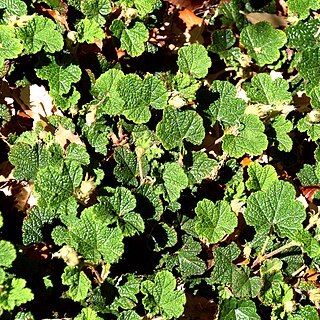Subshrubs low, with creeping stems and ascending leafy shoots. Stems prostrate, rooting at nodes, densely tomentose-villous, with sparse, small prickles, sometimes nearly unarmed, glabrate in age. Leaves simple; petiole nearly as long as leaf blade, tomentose-villous, with sparse, needle-like prickles; stipules free, obovate to ± oblong, 7–12 mm, membranous, margin pectinately or palmately laciniate ca. 1/2 to middle at apex, abaxially hairy, adaxially glabrous; blade broadly ovate to suborbicular, 2–6(–9) × 2–5.5(–9) cm, venation pedate, lateral veins 4 or 5 pairs, raised abaxially, impressed adaxially, leathery, abaxially brownish gray tomentose, with long hairs and sparse, needle-shaped prickles along veins, adaxially dark greenish brown, usually sparsely hairy when young, later glabrous, bullate between veins, base cordate, basal incision to 1 cm deep, margin 3–5-lobed; lobes obtuse, unevenly crenate. Inflorescences terminal and axillary, 1-or few flowered; rachis and pedicels densely tomentose-villous, with sparse, needle-like prickles; bracts obovate to ±oblong, 8–10 mm, apex palmately or pectinately laciniate, hairy. Pedicel 5–9 mm. Flowers to 2 cm in diam. Calyx 1–1.5 cm, abaxially tomentose-villous; sepals ovate or triangular-lanceolate, 8–10 × 4–7 mm, apex laciniate; lobes linear-lanceolate. Petals white, suborbicular or obovate, 7–10 × 6–8 mm, adaxially puberulous, base clawed. Stamens many; filaments to 5 mm; anthers to 1 mm, with few long hairs, rarely glabrous. Pistils fewer than stamens, glabrous. Aggregate fruit yellow to orange or reddish, globose, 1–1.4 × ca. 1 cm, fleshy, with reddish persistent calyx; drupelets obliquely ellipsoid; pyrenes rugose; seeds reniform. Fl. Jun–Jul, fr. Aug–Sep. 2n = 28*, 42*.
A scrambling shrub 2 to 3 m high. It is a ground cover plant. The stems and lower surfaces of leaves and covered with fine soft hairs while the stem and larger veins of the leaves are armed with small spines. The leaves are rough and 3 to 5 lobed and dark green above and brownish underneath. They have a toothed edge. The leaves are crinkled. They turn reddish-brown with frost. The flowers are small and white. The fruit are yellow, fleshy and well flavoured.

